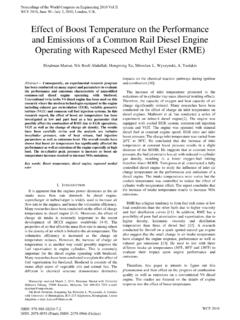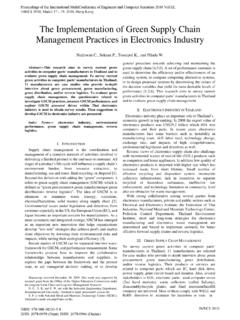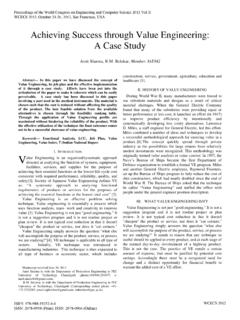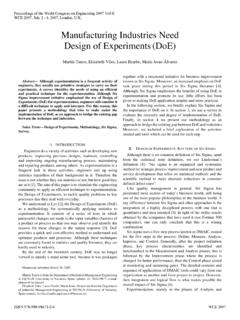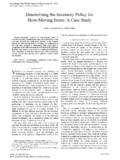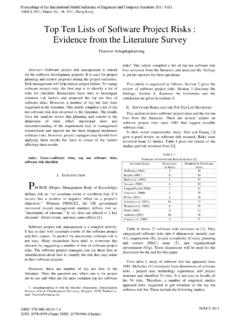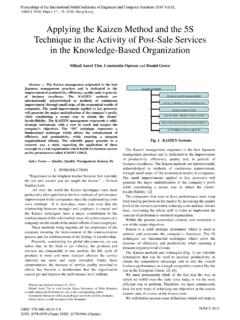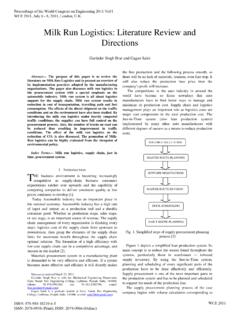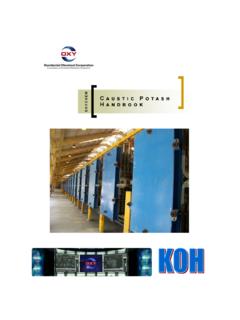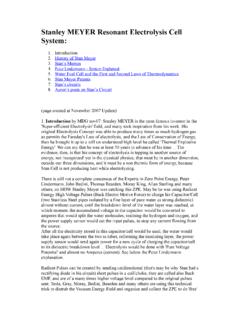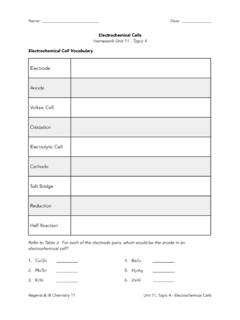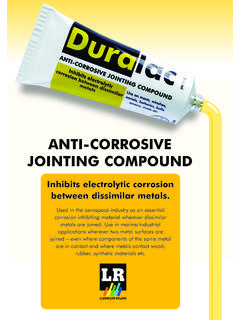Transcription of Hydrogen Fuel Cell Design and Manufacturing Process Used ...
1 Abstract According to the energy crisis that the world faces, the international community requires to offer practical solutions for this problem, Hydrogen fuel cells are a promising one like an option to generate clean energy and solve this crisis. During the last few years of the twentieth century, people have enhanced the interest to expand and use the fuel cell technology. Environmental concerns about global warming and the need to reduce carbon dioxide (CO2) emissions provided the stimulus to seek ways of improving energy conversion efficiency.
2 The Instituto Polit cnico Nacional aims through the development of this type of work to be at the forefront of applied knowledge in the Design and construction of Hydrogen fuel cells . Clean technologies are the technological basis for the Design and manufacture of a Proton exchange membrane fuel cell (PEMFC) or Hydrogen fuel cell technology that are intended to be applied to public transport in Mexico City. This paper describes the Design Process and construction of a Hydrogen fuel cell for specific applications, in this case, bus public transportation.
3 Index Terms Design , fuel cell, Hydrogen , Manufacturing . I. INTRODUCTION Environmental pollution problems as well as the future world energy crisis makes think about saving energy. This applied to the transport means: --Use energy efficiently. --Improve the quality of the environment. In order to satisfy this need, in recent years many automotive companies and people in their own workshops have been developing vehicles propelled by electric motors which are powered with energy supplied by the fuel cells , although at present this technology is very expensive, it is thought that decrease in the future with increasing demand.
4 With the growing cost of oil and concern about global warming, people are becoming interested in cleaner, more fuel -efficient vehicle engines powered by bio-fuels or Manuscript received March 02, 2011; revised March 29, 2011. This work was supported by the Instituto Polit cnico Nacional and Centro de Estudios Superiores del Estado de Sonora. G. L-S. is with the Instituto Polit cnico Nacional and Centro de Estudios Superiores del Estado de Sonora, MEXICO (phone: 653-100-9314; e-mail: G. U-C. is with the Instituto Polit cnico Nacional, MEXICO (e-mail: L.))
5 H. is with the Instituto Polit cnico Nacional, MEXICO (e-mail: G. U-S. is with the Instituto Polit cnico Nacional, MEXICO (e-mail: E. J. is with the Universidad Tecnol gica del Sur de Sonora - Parque SonoraSOFT-IIMM, MEXICO (e-mail: Hydrogen , or by alternative energy technologies like batteries, hybrids and fuel cells . And given the rising cost of electricity and reliability issues with the power distribution system, people will soon be demanding cleaner, alternative energy sources to power heat and cool their homes.)))
6 An ideal technology to do just this is one of the same technologies being developed for cars - fuel cells [12]. fuel cells run on Hydrogen , which can be derived from a variety of fuels ranging from ethanol and methane, to conventional hydrocarbon fuels like propane or natural gas (a reformer is used to extract the Hydrogen ). A fuel cell can be powered by industrially produced pure Hydrogen , a by-product of steam reforming of natural gas. Hydrogen can also be generated from water by electrolysis, decomposing it to oxygen and Hydrogen gas, and solar or wind energy can be used to power this electrolytic Process [33].
7 Instituto Polit cnico Nacional has taken the challenger to introduce the Hydrogen fuel cell Design and construction to be used on the public transport of Mexico City. Some prototypes are currently in testing phase and will most likely be marketed in the first half of next century. The basic operation of the Hydrogen fuel cell is extremely simple. The first demonstration of a fuel cell was by lawyer and scientist William Grove in 1839, using an experiment along the lines of that shown in Figures 1a and 1b. In Figure 1a, water is being electrolyzed into Hydrogen and oxygen by passing an electric current through it [1].
8 In Figure 1b, the power supply has been replaced with an ammeter, and a small current is flowing. The electrolysis is being reversed the Hydrogen (H2) and oxygen (O2) are recombining, and an electric current is being produced. Hydrogen fuel Cell Design and Manufacturing Process Used for Public Transportation in Mexico City G. Luna-Sandoval, G. Urriolagoitia-C, Hern ndez, G. Urriolagoitia-S, E. Jim nez E (a) (b) Fig. 1. (a) The electrolysis of water. The water is separated into hydrogenand oxygen by the passage of an electric current.
9 (b) A small current flows. The oxygen and Hydrogen are recombining. Proceedings of the World Congress on Engineering 2011 Vol III WCE 2011, July 6 - 8, 2011, London, : 978-988-19251-5-2 ISSN: 2078-0958 (Print); ISSN: 2078-0966 (Online)WCE 2011 Another way of looking at the fuel cell is to say that the Hydrogen fuel is being burnt or combusted in the simple reaction, obtained water (H2O) 2H2 + O2 2H2O (1) However, instead of heat energy being liberated, electrical energy is produced. The experiment shown in Figures and makes a reasonable demonstration of the basic principle of the fuel cell, but the currents produced are very small.
10 The main reasons for the small current are: --The low contact area between the gas, the electrode, and the electrolyte basically just a small ring where the electrode emerges from the electrolyte. --The large distance between the electrodes the electrolyte resists the flow of electric current. To overcome these problems, the electrodes are usually made flat, with a thin layer of electrolyte as is in figure 2. The structure of the electrode is porous so that both the electrolyte from one side and the gas from the other can penetrate it.
